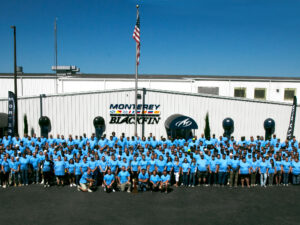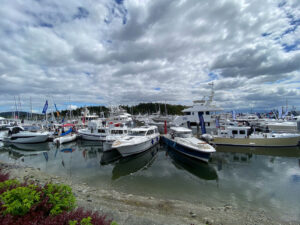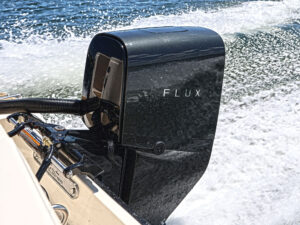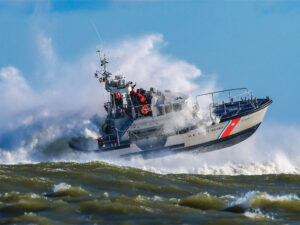Because my test of Grady-White’s new Chesapeake 290 included a day of offshore fishing, I can provide the real-world meaning of numbers that other testers just toss around. For instance, how big is a 56-square-foot cockpit? Big enough for four guys to work a five-rod trolling spread, catch two fish at a time, and not trip over each other. It’s also big enough to allow the wireman and gaffman to slide between an angler and his fish to close the deal. How big is a 265-quart transom fishbox? Big enough to hold 27 mahi-mahi, none of which was a chicken, plus 80 pounds of ice and a tray of rigged ballyhoo. How big is a 206-gallon fuel tank? Big enough to run a fully loaded Chesapeake 290 offshore, troll all day, run back, and still have half a tank of gas. How big is a galley counter with a small sink, microwave, and single-burner stove? Big enough to prepare lunch while the boat is trolling in a beam sea. How big is 6’3″ of cabin headroom? Big enough for a 6′ guy to take a shower in the head without being a contortionist. How big is the midberth in a 29′ walkaround? Big enough for two kids to dub it “the clubhouse,” or a third adult to spend the night. How fast can you comfortably run this boat in 3′-to-5′ seas? We ran two and a half hours in whitecapped slop and averaged 24 mph.
First, a confession: I used to own a walkaround and I didn’t like it. I prefer express boats with their unbroken bows, wider helms, and larger cabins. Nevertheless, I left the testing grounds impressed by the Chesapeake 290. It’s a good sea boat, fishes like a champ, and will admirably weekend a small family. Attention to detail is evident in every feature. Is it the perfect boat? No. For one thing, Grady-White would have to replace the paint-on nonslip on the gunwales with the same raised-diamond pattern found in the cockpit. But I like the boat a lot. And those buyers disposed to walkarounds will be smitten with it.
On Top and Running
Powering my tester was a pair of 250-hp Yamaha F250 outboards. The installation included a walkway in front of the motors for service. Whether to check the oil at the dock or clear fouled props 60 miles off, the ability to position yourself securely at this location is important.
This Chesapeake 290 had full gear, its bottom was painted, and all canvas was deployed. Even so, the F250s made 6000 rpm at WOT, the maximum for these engines and exactly what you want to see when you test a boat. Engines that don’t make high rpm are lugging, or working too hard, which hurts their efficiency and reliability.
By the numbers, the performance provided is good for a beamy, hefty boat such as the Chesapeake 290. Top speed averaged more than 45 mph. For comparison, Pursuit’s OS 285 ($173,590) tops out at 49.1 mph with the same power. At 4200 rpm, we achieved peak efficiency, burning 21 gph while making 31.2 mph, which netted 1.48 mpg. That’s a range of 280 miles. Trolling in swells, we burned between 2 and 3 gph. At cruising speeds, the Yamahas are quieter than competing brands.
This boat’s performance inspires confidence. Although it squatted a bit more than I like while it got on plane, the Chesapeake 290’s helm location and geometry comply with the ABYC recommendation for visibility. I never lost sight ahead and had excellent views all around. Move the levers forward and the boat responds in a controlled rush. If you’ve ever entered an inlet during a big following sea and felt the calm that comes from having enough power to track straight and easily keep up with the swell, you’ll know what it’s like to run the Chesapeake 290.
I was impressed by the ride softness of the Chesapeake 290’s Hunt-designed hull. At first, I was wary of an offshore boat less than 30′ long with a beam of nearly 10′. I expected to be pounded and wet. But I wasn’t. Of course, the Chesapeake 290 isn’t going to get you to the canyons at 35 mph in all situations, but it can be counted on to deliver a comfortable ride at speeds prudent for the prevailing conditions. I’d take it anywhere.
On Deck and Chilling
The transom fishbox is large and has a divider. Bang on its sides. You’ll be rewarded with the solid thunk that indicates heavy insulation. Check the lid. A gasket seals in cold air, and the latch proved its worth on test day against many a tail-whacking whopper.
Forward of this box, in the sole beneath the aft bench, is access to pumps and batteries, plus the seacocks for the air conditioner and generator. Every hose is double clamped. However, I’d like to see the DC negative wires replaced with yellow cables, as suggested by ABYC, to avoid confusion with black 110-volt wiring. Access to head, livewell, washdown pickups, and shower sump is beneath the aft cabin berth.
At the forward end of the cockpit are two raised stowage boxes, the lids of which are fitted with cushions. They’re perfect for sitting and watching the baits or socializing with other crewmembers seated in the aft bench. Like the transom fishbox, these drain directly overboard, instead of relying on pumps. Simple and safe.
Getting to the bow is easy and the walkaround trough made it simple for me to scrub the hardtop and soap the canvas. There are controls for the windlass here and at the helm, a great convenience. Peek into the anchor locker: There’s two-handed access to clear a snarled rode.
Belowdecks, smart features include a Kenyon stove, a faux-granite, fiddled galley counter, and a teak and holly cabin sole. A gloss wood table serves as the V-berth filler. A slatted teak shelf rings the berth.
Smart, serviceable, and seaworthy aren’t words I throw around lightly in boat reviews. But they apply 100 percent to the Grady-White Chesapeake 290.
MSRP: Standard power – $183,625 Test power – $183,625 ****
Grady-White Boats – Greenville, North Carolina; 252-752-2111; gradywhite.com








